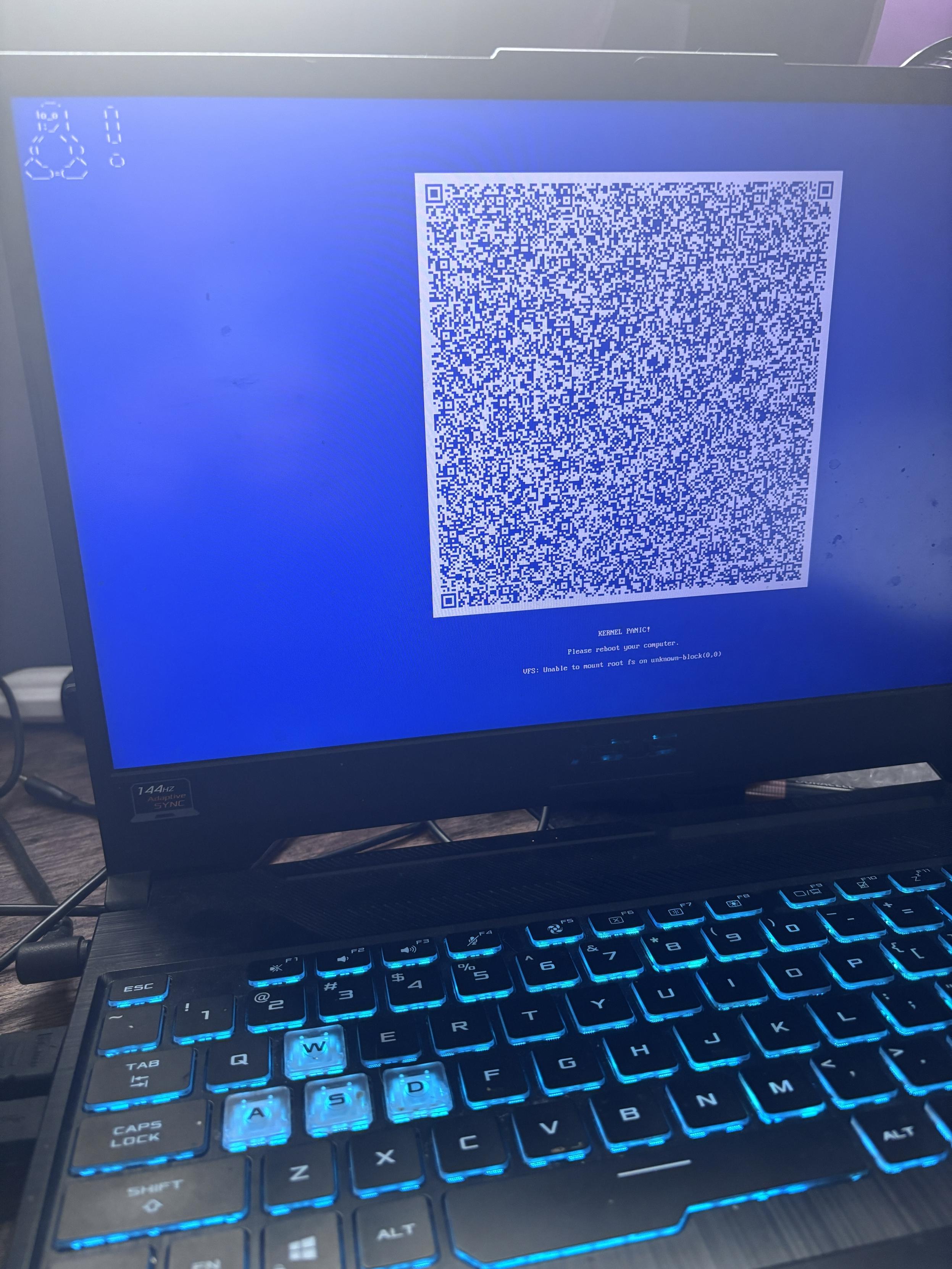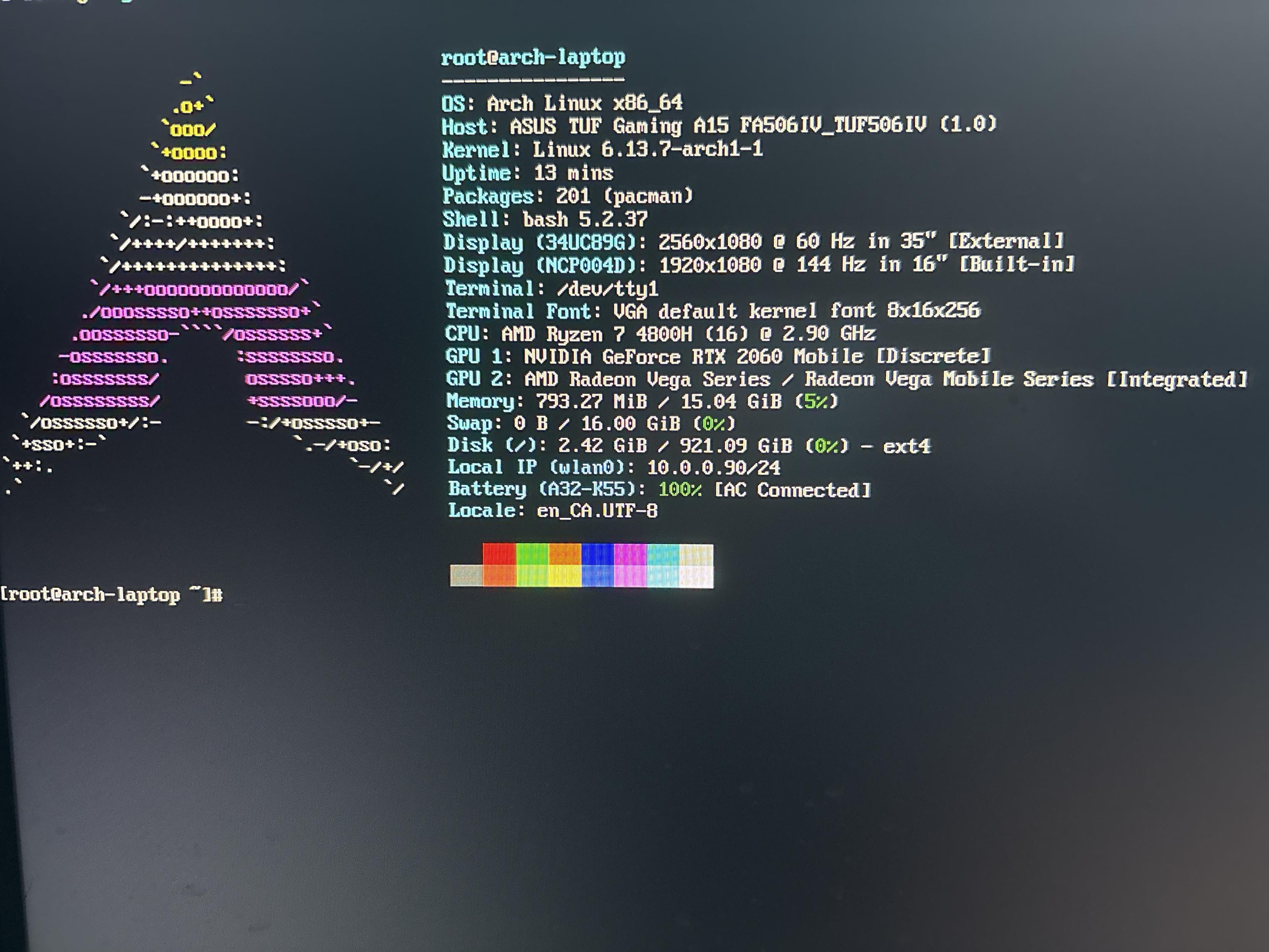I use Arch BTW...
June 17, 2025 @ 17:20
Note: this post doesn't go into detail on the basics of switching to Linux, you can read my previous post on Linux here.
I've been using Linux as my primary OS since around November of last year (2024 to any future readers), and it's been pretty neat. 3 months ago in March I switched from Kubuntu, which I had been using since I started using it full time, to Arch. I guess for context even before I switched to Kubuntu, I had technically previously used a Linux desktop as my primary desktop when my only personal computer I had to myself was a Raspberry Pi 3b+, but that was when I was probably around 11. I did retain some of the basics from that and the occasional webserver configuration, though.
Installing
The basic installation of Arch wasn't all too difficult, but it's pretty clear that they expect you to have some sort of baseline understanding of a couple of CLI tools, or at least of Linux in general so that you can figure it out like I did with some of these. This was especially clear when they get you to partition your disk with a tool called fdisk (or another if you prefer), and they simply give you a few examples of how you could partition the disk and leave the rest up to you.
I did run into a little bit of a problem that was a little bit terrifying... By this point my disk was completely wiped besides the leftover EFI partition so there was no going back, but for some reason when I tried to run pacstrap to install everything to the disk, I would get a kernel panic.

see that big QR code? That's all the error information and it's terrifying when you boot on your computer and see just that...
I tried a few things that didn't work, but eventually I realized the problem was the fact that Arch was trying to download some Linux kernel files to the EFI partition, which was 100mb in size and completely full. I hadn't considered touching it previously because in the wiki they tell you to keep it, presumably more for if you're planning on dual-booting with an existing OS on the computer. I tried resizing it, which weirdly made it show up as having a few gigs of storage but it still filled up at 100mb, so I decided to just wipe it and make a new one.

Success!
Initial setup
When I was setting it up I ended up having to go back onto the bootable USB a few times. The main reason was forgetting to install something important like NetworkManager, which is kinda important for connecting to the internet and doing things. After that though, I was free! I had a fullscreen command line and an 1tb drive with all my important files to my name, and I now get to be one of those Linux users!
I decided the best choice of desktop environment, at least for the moment, was KDE Plasma because I love it and it's very pretty. It's like Windows if it was good. It's also what I used on Kubuntu, hence the K in Kubuntu. (Fun fact, the K in KDE used to stand for "Kool," making it the "Kool Desktop Environment." They don't call it that anymore though.). I would love to try out something a bit different, and I've especially got my eye on Niri, but I just don't have the time to start ricing, or basically, extensively customizing anything at the moment.
Besides that I also took a moment to install yay, a tool that lets you download packages/apps from both the official Arch Linux repository, and the AUR. The AUR or "Arch User Repository" is something people brag a lot about when talking about Arch Linux. Basically what it is, is a large community-run repository of build scripts. They download files, move things, and install stuff, but since they're community maintained they're usually pretty up-to-date and can be very customized to work perfectly on the average Arch system. A lot of them also build the apps from source which takes FOREVER.
Some problems
I've had a lot of very specific issues that I've eventually solved. A lot of them end up being "you don't have this installed, you should install it," but they're just not things you tend to think about when normally using a computer.
The biggest one that still haunts me to this day, is just the fact that for some reason I can't mount my NTFS formatted external drive through KDE Plasma. I've got ntfs-3g installed, yet it still gives me an angry message when I try to mount it. Honestly this one hasn't been a huge issue though. If I instead run sudo mount ... to mount the disk it mounts fine so I just wrote up a simple bash script that sits on my desktop that mounts it:
#!/bin/bash
pkexec mount --mkdir /dev/sda1 /mnt/Backup
xdg-open /mnt/Backup/pkexec is equivalent to sudo, it just brings up a gui password input field in KDE so I can just double click it and type my password in. xdg-open also just opens the folder in my file manager, in this case, Dolphin.
The other big problem I had I actually ended up solving yesterday. Basically, my printer wouldn't print. I tried installing all the typical HP drivers people recommend, but it wouldn't detect it properly or just wouldn't be able to communicate with the printer. I ended up getting my solution from a random Arch user on the Ubuntu wiki, which feels like a strange place to find them but it worked. Printer now prints. Things are right in the world!
I feel like I have had other weird specific issues, I think at one point I couldn't get KDE Connect to uhh... connect... but most of them were fixed with a bit of searching online. The Arch Linux wiki is extremely helpful.
Keeping up-to-date
At least with how I use my computer, the issue of computers suddenly not working hasn't really shown up. I just run yay -Syu whenever I remember to (almost every day) and it updates my things. It's also nice cause Kubuntu only updates when Ubuntu does, which is not super frequently so your KDE tends to get out of date pretty quickly, while over here I get the newest release pretty much as soon as it's out.
General stuff moving onward
Something pretty big I've noticed is that with most software I install, it tends to just work. I've had almost constant issues using some of the specific software I typically use on Ubuntu-based distros, they just don't like to work sometimes for some reason. Meanwhile over here, I've been able to install some things and genuinely gasped when I click on them and then they open. I also like that with KDE Plasma specifically (not sure about other DEs) it's super easy to set up WINE to automatically run any EXE and MSI files so it's pretty much capable of running everything I may ever want to.
Moving forwards my main goals are to build an AMD-based PC so that I can use DaVinci Resolve, the Linux version HATES Nvidia, and to get a Framework laptop cause they're cool and I've heard tiling window managers are especially useful on laptops where you have smaller screen real-estate. Technically I'm using a laptop right now, but I also wouldn't call this a very genuine "laptop" experience.
(yes my laptop has an antenna, the built-in wifi card sometimes just stops working for hours on end. This has been an issue since I used Windows, it's ASUS' fault.)
Excited for wherever I go from here, it's very fun screwing with my 'puter and making it do silly things. Goobye :>



